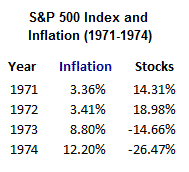Inflation can adversely affect corporate profits, household discretionary spending, and stock prices. Rising costs for raw materials have a dampening effect on profits. Increasing costs of food and energy begin to account for larger and larger portions of a household’s disposable income. From an investment perspective, when the annual inflation rate jumped significantly between 1971 and 1974, stock market (SPY) returns eventually suffered as shown below.

With the Fed creating asset inflation via quantitative easing, it is important investors keep their eye on the inflation ball over the next six to eighteen months. Aaron Smith, managing director of Superfund Financial Ltd. and Superfund USA Inc., told Bloomberg:
Coffee, sugar and cocoa prices will rise five- to 10-fold by 2014 because of shortages that will mean consumers getting “swamped” by food-price inflation, according to Superfund Financial.
A lack of farmland and rising costs means growers will fail to keep up with demand.
“There’s a tremendous shortage of food, there’s a tremendous shortage of arable land. Any kind of food products are going to increase.”
The negative effects of rising food prices are amplified in many emerging countries since food makes up a larger percentage of household spending than in more developed nations, such as the United States. Inflation contributed significantly to the somewhat rare outperformance of U.S. stocks relative to the emerging markets between October 2010 and February 2011 (see below).
Understanding any projection spanning roughly 40 years is subject to significant revisions over time, the figures highlighted by Bloomberg below are still unnerving:
World food production will have to increase by 70 percent by 2050 to meet increasing demand from an expanding global population, projected to rise to 9.1 billion by 2050 from 6.9 billion now, Hiroyuki Konuma, the UN Food and Agriculture Organization’s regional representative in Asia, said in an interview in Bangkok on March 9.
On March 15 we showed the impact of QE2 on asset prices. With food prices rising at rapid rates and oil sitting at almost 7 per barrel, the Fed is caught between the proverbial rock and a hard place. The hard place is the deflationary forces that still exist in the form of excess debt, excess capacity, high unemployment, and strained balance sheets. The rock is the rising threat of inflation. If the Fed bows to inflation, global stock markets will be forced to stand on their own, which did not go well after the Fed closed the books on QE1. QE2 is slated to be wrapped up in June.
The markets have rebounded impressively off extreme oversold conditions that were present on March 16. While the current advance is somewhat tentative, it remains possible the S&P 500 could march toward 1,400 or 1,440 before inflation or the absence of quantitative easing spooks investors. The CCM 80-20 Correction Index closed Thursday at 1,206, a level that historically corresponds to favorable market outcomes more often than not. The risk-reward ratios of 6.06, 7.10, and 9.08 looking out six, nine, and twelve months respectively are attractive (see table below).
On March 28, we outlined some issues, including the end of QE2, which we continue to believe necessitate a flexible approach to the markets. We are happy to hold our current positions and have been redeploying cash since March 17 into energy (XLE), materials (XLB), commodities (DBC), and mid-caps (IWP). Rationale for favoring these areas of the market was provided on March 21 and March 23.








